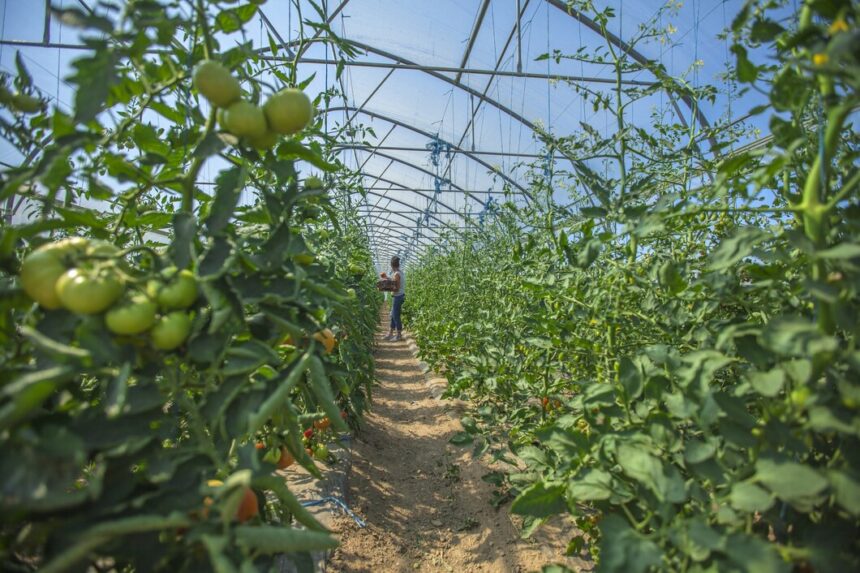Tomatoes are one of the most popular and widely cultivated vegetables in South Africa, prized for their versatility and high market demand. Growing tomatoes from seed to harvest requires careful attention to detail, including soil preparation, pest management, and appropriate fertilization. This article provides a comprehensive guide for South African farmers on the entire tomato growing process, including inputs, machinery, potential diseases, and optimal care practices.
1. Land Preparation
Soil Type:
Tomatoes thrive in well-drained, fertile soils with a pH of 6.0 to 6.8. Sandy loam or loamy soils are ideal as they provide good drainage and nutrient-holding capacity.
Land Preparation Steps:
- Tilling: Begin by tilling the land to a depth of at least 30 cm to break up compacted soil and improve aeration.
- Soil Testing: Conduct soil tests to determine nutrient levels and pH. Amend the soil based on test results.
- Adding Organic Matter: Incorporate organic matter, such as compost or well-rotted manure, to improve soil fertility and structure.
2. Seed Selection and Sowing
Choosing the Right Seeds:
Select tomato varieties suited to the local climate, disease resistance, and market preference. Popular varieties in South Africa include:
- Roma: Good for processing.
- Cherry Tomatoes: Sweet and popular in fresh markets.
- Beefsteak: Large and juicy, ideal for sandwiches.
Sowing Process:
- Seedling Preparation: Start seeds in seed trays or pots indoors 6-8 weeks before the last frost date.
- Soil Mix: Use a seed-starting mix with good drainage. Moisten the mix before planting.
- Germination Conditions: Maintain a temperature of 20-25°C with plenty of light. Germination usually occurs within 7-14 days.
3. Transplanting
Timing:
Transplant seedlings outdoors when they are 15-20 cm tall and after the danger of frost has passed.
Transplanting Steps:
- Spacing: Space plants 60-90 cm apart in rows 1.2-1.5 meters apart.
- Hole Preparation: Dig holes slightly larger than the root ball and mix in compost to enhance soil fertility.
- Watering: Water seedlings immediately after transplanting to reduce transplant shock.
4. Growth Stages
Vegetative Stage:
During this stage, the plant focuses on leaf and stem growth.
- Watering: Provide 2.5-5 cm of water per week, adjusting based on rainfall. Water deeply but infrequently to encourage deep root growth.
- Fertilization: Apply a balanced fertilizer (NPK 10-10-10) at planting and follow up with a nitrogen-rich fertilizer when the first flowers appear.
Flowering Stage:
Tomatoes start to flower about 6-8 weeks after transplanting.
- Pollination: Ensure good pollination by shaking plants gently or attracting bees.
- Pest Management: Watch for pests like aphids and whiteflies. Introduce beneficial insects like ladybugs or use insecticidal soap as needed.
Fruit Development:
Fruits begin to develop 2-3 weeks after flowering.
- Watering: Continue consistent watering. In hot weather, increase frequency to prevent blossom drop.
- Fertilization: Switch to a low-nitrogen, high-potassium fertilizer to support fruit development.
5. Harvesting
Timing:
Tomatoes are ready to harvest when they are fully colored and firm to the touch. This usually occurs 70-90 days after transplanting.
Harvesting Method:
- Manual Harvesting: Use pruning shears to cut tomatoes from the vine, leaving a small stem attached.
- Timing: Harvest early in the morning or late afternoon to avoid heat stress.
6. Storage
Post-Harvest Handling:
- Cleaning: Gently wash tomatoes to remove dirt and debris.
- Storage Conditions: Store in a cool, dark place. Ideal storage temperature is around 10-15°C. Avoid refrigerating, as it can affect flavor and texture.
7. Pests and Diseases to Watch For
Common Pests:
- Aphids: Small insects that suck sap; control with insecticidal soap or neem oil.
- Whiteflies: Can spread diseases; use yellow sticky traps to monitor populations.
- Tomato Hornworm: Large caterpillars that defoliate plants; handpick or use Bacillus thuringiensis (Bt).
Diseases:
- Blossom End Rot: Caused by calcium deficiency; prevent by ensuring consistent watering and proper fertilization.
- Powdery Mildew: Fungal disease that flourishes in humid conditions; manage by ensuring good air circulation and using fungicides when necessary.
- Late Blight: A serious disease causing leaf spots; use resistant varieties and fungicides if detected early.
8. Pesticide and Herbicide Use
Application Guidelines:
- Integrated Pest Management (IPM): Prioritize non-chemical methods first, like introducing beneficial insects or using physical barriers.
- Chemical Control: When necessary, choose selective pesticides targeting specific pests and apply them according to manufacturer instructions. Always follow safety guidelines and harvest intervals.
Growing tomatoes in South Africa requires a comprehensive understanding of the entire process from seed to harvest, including careful attention to soil health, pest management, and proper irrigation techniques. By following these guidelines, farmers can enhance their tomato production and achieve sustainable yields, contributing to food security and economic viability in their communities. With a proactive approach to farming and pest management, South African farmers can enjoy the rewards of growing one of the country’s most beloved crops.
Join 'Farmers Mag' WhatsApp Channel
Get the latest Farming news and tips delivered straight to your WhatsApp
CLICK HERE TO JOIN






